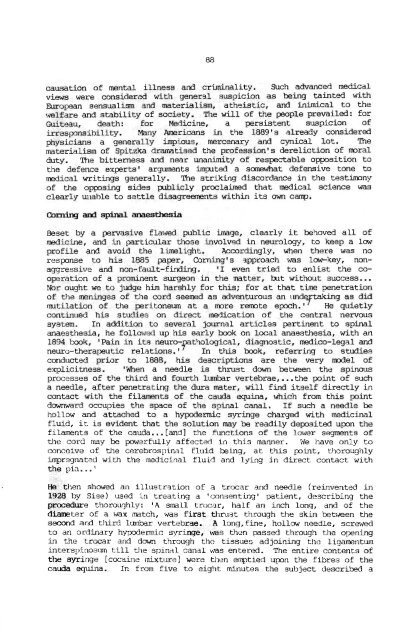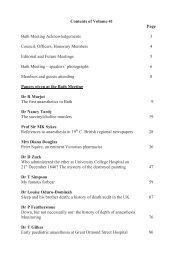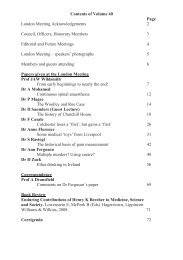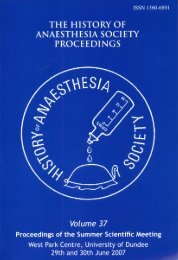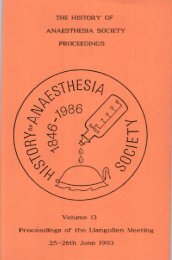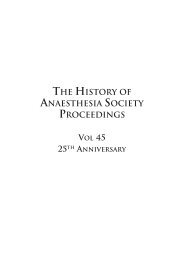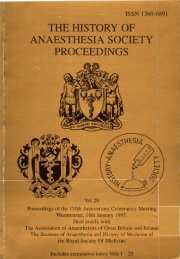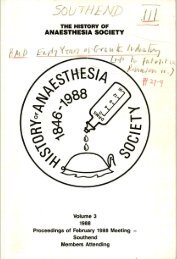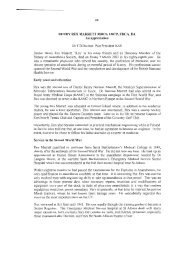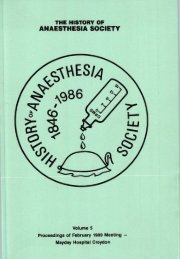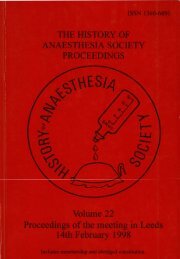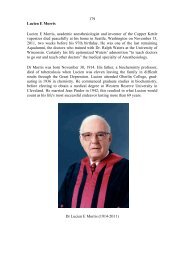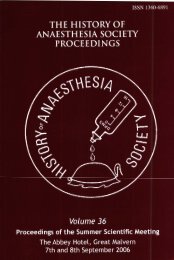Volume 9b - History of Anaesthesia Society
Volume 9b - History of Anaesthesia Society
Volume 9b - History of Anaesthesia Society
You also want an ePaper? Increase the reach of your titles
YUMPU automatically turns print PDFs into web optimized ePapers that Google loves.
camation <strong>of</strong> mental illness and criminality. Such advanced medical<br />
views were considered with general suspicion as being tainted with<br />
European sensualism and materialism, atheistic, and inimical to the<br />
welfare and stability <strong>of</strong> society. The will <strong>of</strong> the people prevailed: for<br />
Guiteau, death: for Medicine, a persistent suspicion <strong>of</strong><br />
uraspnsihility. Many Americans in the 1889's already considered<br />
physicians a generally impious, mercenary and cynical lot. me<br />
l~terialisrn <strong>of</strong> Spitzka dmtised the pr<strong>of</strong>ession's dereliction <strong>of</strong> mral<br />
duty. The bitterness and near unanimity <strong>of</strong> respectable opp3sition to<br />
the defence experts' arguments implted a somewhat defensive tone to<br />
medical writings generally. The striking discordance in the testhny<br />
<strong>of</strong> the owsing sides publicly proclaM that medical science was<br />
clearly unable to settle disagreements within its own camp.<br />
Comhq and spinal -ia<br />
Beset by a pervasive flawed public image, clearly it behoved all <strong>of</strong><br />
medicine, and in particular those involved in neurology, to keep a low<br />
pr<strong>of</strong>ile and avoid the limeliqht. Accordingly, when there was no<br />
response to his 1885 paper, Coning's approach was low-key, nonaggressive<br />
and non-fault-finding. 'I even tried to enlist the co-<br />
operation <strong>of</strong> a pruninent surgeon in the matter, but without success. ..<br />
Nor oughtwe to judge him harshly for this; for at that time penetration<br />
<strong>of</strong> the meninges <strong>of</strong> the cord seemed as adventurous an ~rnd~eftaking as did<br />
niutilation oE the peritoneum at a mre remte epoch. He quietly<br />
continued his studies on direct medication <strong>of</strong> the central nervous<br />
system. In addition to several journal articles pertinent to spinal<br />
anaesthesia, he followed up his early book on local anaesthesia, with an<br />
1894 hook, 'Pain in its neuro-fatholqical, diagnostic, medico-legal and<br />
neuro-therapeutic relations. In this book, referring to studies<br />
cond~lcted prim to 1888, his descriptions are the very model <strong>of</strong><br />
explicitness. 'When a needle is thrust down between the spinous<br />
processes <strong>of</strong> the third and fourth lwlbar vertebrae,. ..the pint <strong>of</strong> such<br />
a needle, after penetrating the dura mater, will find itself directly in<br />
contact with the filaments <strong>of</strong> the cauda equina, which from this point<br />
downward occupies the space <strong>of</strong> the spinal canal. If such a needle be<br />
hollow and attached to a hypodermic syringe charged with medicinal<br />
fluid, it is evident that the solution may be readily depsited upon the<br />
filaments <strong>of</strong> the cauda ...[and] the functions <strong>of</strong> the lower sqments <strong>of</strong><br />
the cord my be psrfully affect& in this manner. We have only to<br />
conceive <strong>of</strong> the cerebrospinal fluid bhg, at this pint, thoroughly<br />
impregnated with the medicinal fluid and lying in direct contact with<br />
the pia. . . '<br />
He then showed an illustration <strong>of</strong> a trocar and needle (reinvented in<br />
1928 by Sise) used in treating a 'con~enting' patient, describing the<br />
procedure thoroughly: 'A small trocar, half an inch long, and <strong>of</strong> the<br />
diameter <strong>of</strong> a wax match, was first thrust through the skin between the<br />
second and third l&r vertebrae. A long,fine, hollow needle, screwed<br />
to an ordinary hypdemic syringe, was then passed through the opening<br />
in the trocar and dawn through the tissues adjoining the ligamenturn<br />
interspinosum till tile spinal cans1 rvas entered. The entire contents <strong>of</strong><br />
the syringe [cocaine mixture] were then emptied upon the fibres <strong>of</strong> the<br />
cauda +a. In from five to eight minutes the subject described a


